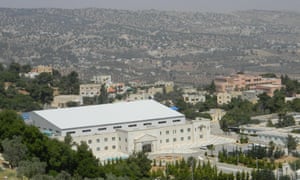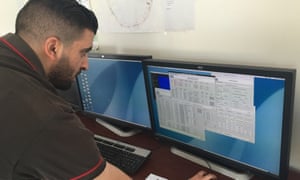No Boundaries, No Hostilities in Collaborative Science
"Today sees the fulfillment of many hopes and dreams. The hope that a group of initially inexperienced young people could build SESAME and make it work - they have: three weeks ago SESAME reached its full design energy. The hope that, nurtured by SESAME’s training program, large numbers of scientists in the region would become interested in using SESAME – they have: 55 proposals to use the first two beamlines have already been submitted. And the hope that the diverse Members could work together harmoniously."
"As well as being a day for celebration, the opening is an occasion to look forward to the science that SESAME will produce, using photons provided by what will soon be the world’s first accelerator powered solely by renewable energy."
President of the SESAME Council, Professor Sir Chris Llewellyn Smith
"We call it the light at the end of the tunnel."
"Jordan was the site [the Jordanian desert]. It was where everybody could come."
"I actually got to live in a universe where Arabs, Israelis, Iranians, Pakistanis work together for the same cause for their own people, for humanity. And that definitely feels good."
Eliezer Rabinovici, theoretical physicist, Hebrew University, Jerusalem
 |
| The Synchrotron-Light for Experimental Science and Applications centre (known as Sesame) in Jordan. Photograph: http://www.sesame.org.jo/ |
Dr. Rabinovici has had the rare good fortune to see his efforts of twenty years bearing fruit. It is for that length of time that he has been involved in hoping to create a Middle Eastern Science Committee. In 1993 he had been working at CERN, on the Large Hadron Collider, of the European Organization for Nuclear Research near Geneva, where five years ago the Higgs boson was finally found.
A colleague from Italy, Sergio Fubini, planted the seed of an idea in Dr. Rabinovici's head by telling him it was time he placed his "naive idealism" to the test. With that prodding Drs. Rabinovici and Fubini set out to create the Middle Eastern Science Committee, leading to a meeting in November 1995 in Egypt where scientists from around the Middle East were assembled.
German scientists offered the group an old accelerator nicknamed Bessy. Bessy had once served in Berlin as a light source and at that juncture she was being replaced. The accelerator was dismantled and then shipped in boxes to the site in the Jordanian desert where the group was preparing to set itself up to fully engage in the serious business of scientific investigation into the energy of light.
The group had named itself SESAME, the name derived from an acronym for Synchrotron-light for Experimental Science and Applications in the Middle East. May 16 was its official opening. SESAME is comprised of physicists from Cyprus, Egypt, Iran, Israel, Jordan, Turkey and Pakistan, and including the Palestinian Authority; a membership whose scientists are dedicated to collaboration in the name of science.
His Majesty King Abdullah II following the opening of SESAME,
flanked by Heads of the delegations of the SESAME Members and Directors
of International Organisations that have supported SESAME**. (Image:
Noemi Caraban Gonzalez/CERN)
The institute has been established with the particle accelerator known as a synchrotron, to study the phenomenon of speeding electrons. These scientists are invested in harnessing the electrons in a 'dance' which would emit powerful beams of radiation, called synchrotron light, and that light made use of, to study properties of materials, from semiconductors to viruses.
Throughout the world about sixty such light sources exist and are studied for their increasing value as tools in medicine and engineering. Scientists in California using X-rays from a light source, discovered recently new details in the structure of proteins regulating blood pressure. That insight raises the possibility of improved treatment for hypertension.
CERN, viewed by SESAME as a guide toward their own potential for success came about when UNESCO conceived of reviving science in Europe post World War II, and at the same time fostering the Continent's capacity to cooperate in a time of peace, as a means of keeping the peace and furthering science at the very same time.
Dr. Christopher Llewellyn Smith, Oxford University physics professor, and now president of the SESAME Council, observes that the major difference lies in the fact that hostilities in Europe have long since passed, whereas in the Middle East they are alive and thriving. Synchrotron light sources' study is meant to transform wasted energy into a scientific tool.
In machines like the Large Hadron Collider, as charged particles accelerate around an electromagnetic racetrack, they radiate energy, called synchrotron radiation. Arrays of magnets called wigglers and undulators can be inserted to induce the electrons to dance, producing powerful pencil-beams of light types. The manner in which these beams of light are absorbed by target materials, or reflected, can reveal molecular arrangements and shapes in the manner in which the double helix of DNA had been revealed by X-ray photographs in the 1950s.
A grant from the European Union enabled CERN to assist in building the magnets and to supervise construction of the SESAME machine, part of the $90-million raised to date to make the project possible. Jordan offered another $7 million for a solar power plant to result in Sesame presenting as the first accelerator worldwide to be powered through renewable energy.
 |
| A worker looks at research data at the Sesame facility. Photograph: Kareem Shaheen |
Labels: Collaboration, Middle East, Physics, Research, Science


0 Comments:
Post a Comment
<< Home